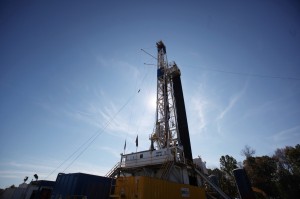 Natural gas futures were orbiting last sessions close during early trade in Europe today. The blue fuel logged another sizable daily loss yesterday, as weather over highly populated areas in the US cools and record output from shale extraction was reported.
Natural gas futures were orbiting last sessions close during early trade in Europe today. The blue fuel logged another sizable daily loss yesterday, as weather over highly populated areas in the US cools and record output from shale extraction was reported.
Front month natural gas futures, due in August, were up 0.12% at the New York Mercantile Exchange to trade for $4.102 per million British thermal units at 8:17 GMT today. Prices ranged from $4.084 to $4.103 per mBtu. The contract added lost 1.21% on Tuesday, reaching a six-month low of $4.081 per mBtu, after a 0.02% gain on Monday.
The Marcellus shale deposit in the US Northeast is logging record output, as gross output from the region will average 15.235 billion cubic feet a day this month, up 28 percent from a year earlier, the EIA said in a report on Monday.
“This is the latest round of big numbers from the Marcellus,” Martin King, an analyst with FirstEnergy Capital Corp. in Calgary, said for Bloomberg yesterday. “There’s too much supply in the region and there’s not enough takeaway capacity. That regional sentiment is probably weighing on Nymex prices to some degree.”
NatGasWeather.com suggested an injection of 95-100 Bcf will be reported in this week’s log, about 25 Bcf more than the 5-year average gain for the reported week. However, next week’s build up is suggested to be some 45-50 Bcf above the average, which would be the biggest gain this summer season.
The official report for the week ended July 11 is due this Thursday.
US weather outlook
NatGasWeather.com reported on Wednesday that the cold blast from Canada continues southwards through the eastern and central US, to reach as far as Texas, dragging temperatures down. Readings behind the cool front are projected to be some 15-20 degrees Fahrenheit below average at places. The system will also bring many showers and locally heavy rains. The extreme southern and the western US remain in the grips of strong and resilient high pressure, supporting the moderately high temperatures. Later this week, higher pressure will be coming to the Midwest and Northeast as well, normalizing temps after the cold Canadian blast. Cooling demand over the next seven days will probably be low-to-moderate.
In the 8-14 day outlook, NatGasWeather.com projected a slightly warmer trend for the US. Higher pressure will be returning to the northeastern half of the US after the cooler Canadian system passes by early in the projected period. However, more blasts will be pushing southwards into the Northeast and Midwest later in the period, probably lowering temps again.
According to AccuWeather.com, New York will be slightly cooler than normal today, with temperatures between 66 and 81 degrees Fahrenheit, a few below average. Some rain and a thunderstorm are expected today, before a sunny remainder of the week, though temps will remain relatively unchanged at slightly below-seasonal levels. Chicago will be sunny, though cooler-than-normal today, with readings ranging 57-70, some 15 degrees below average. Readings will be climbing for the rest of the week, though temps will probably remain below-normal through to next week.
In the South, Houston will see moderately warm weather today, with readings between 75 and 92 degrees Fahrenheit. Thunderstorms are bound for today and the following few days, while temperatures will probably remain little changed. Over on the West Coast, Los Angeles will be sunny, though cooler than normal today, with temperatures ranging 63-77 degrees, a few below average. Readings will slowly drop to stand several degrees below average ahead of the weekend, when they will bounce back up again.
Technical view
According to Binary Tribune’s daily analysis, in case natural gas for settlement in August penetrates the first resistance level at $4.143 per million British thermal units, it will encounter next resistance at $4.189. If breached, upside movement will probably attempt to advance to $4.220 per mBtu.
If the energy source drops below its first resistance level at $4.066 per mBtu, it will see support at $4.035. If the second key support zone is breached, the power-station fuel’s downward movement may extend to $3.989 per mBtu.





